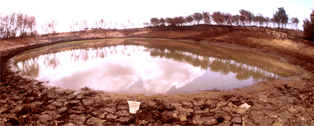 The World
Health Organization estimates that warming and precipitation trends over the
past 30 years killed 150,000 people annually and caused health problems in an
additional 5 million people. And with the Intergovernmental Panel on Climate
Change predicting average global temperatures to rise between 1.4 and 5.8 degrees
Celsius by 2100, climate scientists, physicians and others are warning of a
possible increase in heat-related deaths and disease outbreaks.
The World
Health Organization estimates that warming and precipitation trends over the
past 30 years killed 150,000 people annually and caused health problems in an
additional 5 million people. And with the Intergovernmental Panel on Climate
Change predicting average global temperatures to rise between 1.4 and 5.8 degrees
Celsius by 2100, climate scientists, physicians and others are warning of a
possible increase in heat-related deaths and disease outbreaks.Ponds, such as this one near Alem Kitmama, Ethiopia, are breeding grounds for mosquitoes, which can carry malaria. New research indicates that climate change may bring on more incidences of malaria, as well as other diseases. Image copyright of WHO/P. Virot.
The climate events that researchers are now looking at with an eye toward human health include not only heat waves but also extreme events such as hurricanes. For example, in 1998, Hurricane Mitch dropped almost 2 meters of rain on Central America in three days, with related incidences of malaria, dengue fever and cholera soaring in the following weeks. In 2000, rain and three cyclones inundated Mozambique for six weeks, after which malaria rose fivefold.
More recently, amid the many lasting repercussions of Hurricane Katrina’s fatal strike on the U.S. Gulf Coast, is something known as “Katrina’s cough,” says Paul Epstein, a doctor and researcher at Harvard Medical School. The cough may be caused by the prevalence of mold, toxins in the air and water, or the oil spills left over from the blow.
“We have long known about the immediate problems associated with extreme events, such as flooding, but it is the aftermath and the biological impacts that we have been underestimating,” says Epstein, who discussed these links in the Oct. 6 New England Journal of Medicine and in a report released Nov. 1 called Climate Change Futures. Taken individually, he says, extreme events in recent years might be anomalous, but together, they indicate a trend: “Climate is changing, and such events are becoming more probable.”
Certainly some links between climate change and human health are stronger than others, and understandably there is some skepticism, says Jonathan Patz, a researcher at the University of Wisconsin in Madison, who published an article in the Nov. 17 Nature about such connections. For example, although models show a link between climate change and increased intensity of hurricanes, the link between hurricane frequency and climate change is more tenuous (see Geotimes, December 2005). Models, however, indicate that the risks of extreme events, such as the European heat wave of 2003, have more than doubled because of climate change, he says.
The strongest climate and health connection is heat-related mortality, says Jeffrey Shaman, a climate scientist at Oregon State University in Corvallis. “Here, we have a direct mechanism [for the deaths], and temperatures are the culprit,” he says. Unlike connections between diseases and climate change, there is no chain of events with temperature-related deaths: It’s a simple cause-effect relationship. More tenuously connected, however, are climate and diseases, such as malaria or West Nile Virus, Shaman says.
Although water, temperature and other environmental factors can affect the survival and distribution of infectious agents (for example, bacteria and viruses) and their disease-carrying vectors (for example, mosquitoes and ticks), “I haven’t seen the follow-through” to indicate what the direct causes of disease outbreaks may be, Shaman says. The “causal mechanism” of the spread of disease is not as clear-cut.
Still, Patz says, “we can definitely see correlations,” pointing to malaria outbreaks that have been associated with anomalously high temperatures in Kenya and India, and dengue fever outbreaks in Central America, which have been linked to higher temperatures and moisture. “It is clear that the intense rains and increased flooding associated with a changing climate can precipitate clusters of infectious diseases carried by mosquitoes, rodents and by water,” Epstein says.
Other connections, such as that between plague outbreaks in the American Southwest and climate change, may not be quite as obvious, Patz says. Researchers, however, have observed that following anomalously heavy rainfall, rodent populations that carry the plague expand, thus leading to more human cases. And, Patz says, his team’s model simulations have correctly “predicted” the past observed trends.
“Nailing down the exact effects of climate change on health is difficult,” partially because so many factors are involved in determining how bad a disease outbreak will be, says Cynthia Rosenzweig, a climate researcher with NASA’s Goddard Institute for Space Studies in New York City. “It is important that we learn about all the factors that are involved” in the spread of disease, she says, especially with the World Health Organization estimating that climate-change-induced health risks will more than double in the next 25 years.

